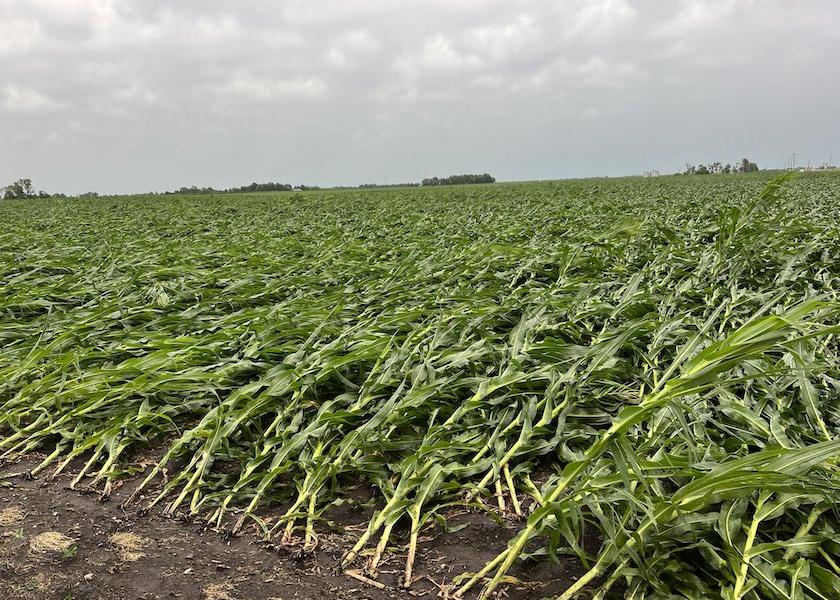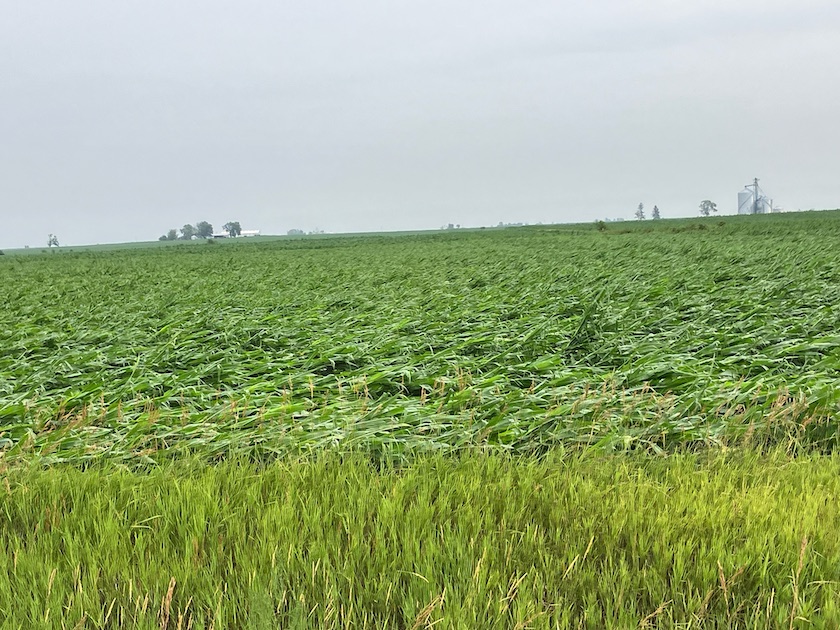Derecho Packs Punch of 100 MPH Winds, Flattens Cornfields and Crushes Grain Bins Across the Midwest

Hurricane-force winds swept through northern Missouri and Iowa and all the way east to Illinois and Indiana on Thursday. The derecho brought wind gusts up to 100 mph in places, flattening cornfields. The storm system also brought crucial rains. While it might not be enough to cure the drought, the rains could help rescue some of the drought-ravaged crops.
According to Accuweather, a derecho is a storm that brings a punch of at least 58 mph winds over the span of at least 400 miles. The storm on Thursday barreled across the Midwest, with some of hardest-hit states being Iowa, Illinois and Indiana. The storm then turned and went south, hitting Tennessee.
Yesterday, @NOAA's #GOESEast 🛰️ tracked a destructive #derecho as it raced across the Midwest, causing widespread damage across several states. This visible imagery shows the bubbling clouds, and the satellite's Geostationary Lightning Mapper allowed us to see the frequent… pic.twitter.com/SvYbnuf5em — NOAA Satellites (@NOAASatellites) June 30, 2023
Ken Ferrie, owner of Crop-Tech Consulting, was in the middle of the storm. He spoke to AgWeb's Rhonda Brooks about potential damage, estimating the derecho crossed at least two-thirds of Illinois.
“It's pretty widespread,” says Ferrie who lives in Heyworth, Ill., just south of Bloomington. “It hit between 12:30 p.m. to 1 p.m. yesterday.”
The storm also brought more than an inch of much-needed rain, which may have saved many of the Illinois corn and soybean crops. Ferrie says there is quite a bit of cleanup that will need to take place with down trees and other damage, and he’s still trying to assess the impact on the crops.
“I have not seen any corn snapped like the derecho in Iowa where crops were just snapped and flat, but there's a lot of corn laying over,” says Ferrie.
USDA meteorologist Brad Rippey says the storm was widespread, impacting an area from the Central Great Plains and northern Missouri, all the way to the Tennessee River Valley.
"The derecho on June 29th was oddly reminiscent of the massive derecho that struck the Midwest on August 10, 2020," he says. "Now the aerial extent was not quite as large as the August 2020 events and the winds were not quite as high. But nevertheless, we did see widespread 60 to 100 mph winds emerging early in the day on the 29th."
Brad Rippey discusses the scope and possible scale of damage caused by the derecho this week.
Rippey says the timing of the storm could also be a key factor in determining how much damage it caused to crops.
"We're not expecting to see the large scale impact that we saw compared to August 2020, partly because it's earlier in the growing season crops are not as high and susceptible to damage," says Rippey. "And also just the fact that winds weren't quite as high and the areal extent wasn't as great. Still, though, another blow for producers already reeling from drought now contending with the effects of a significant windstorm that blew through the area on June 29th."
Earlier Planted Corn Hit the Hardest
Ferrie drove across parts of Illinois and into Iowa on Friday, and says he thinks the earlier planted corn is what will be impacted the most from the powerful storm this week.
“April-planted corn is pushing tassels and trying to pollinate, so unfortunately, it'll get hit the hardest because it's hard for tasseled corn to stand back up; it'll just curve at the top,” says Ferrie. “And that down corn creates pollination problems. So, from a yield problem that'll be the tough spot, and that'll be the tougher stuff to harvest because it just won't stand back up.”
First time in my life I’ve pulled up to my parents place and not seen the grain leg standing. The storm hit hard today, but it’s wild in that the corn didn’t get mangled any worse than it did. No one got hurt which is the main thing. pic.twitter.com/Kg0hVyKi5V — Matthew Bennett (@chief321) June 29, 2023
He says the May-planted corn will still have time to stand back up and recover, but he also points out the later planted corn is seeing more impacts from the drought in Illinois. The corn that farmers planted later didn’t establish good roots as it has seen little to no rain since planting. That made the corn more vulnerable to wind damage.
“We have a lot of acres that are getting what I call restless corn syndrome and struggling to get crown roots made. And that stuff isn't pollinating. It's the later planted crop that's probably some of the worst,” says Ferrie.
Storm damage in Illinois from today. Any damage to your farm? pic.twitter.com/RWOHDjPQ2U — IL Corn (@ilcorn) June 29, 2023
While the wind may impact yields and create harvest issues for some of the crops, the water came at a crucial time, especially in Illinois.
“That inch of water, many farmers would probably take the wind in the corn to get the water, because it looked like we weren’t going to get any of it, and suddenly our forecast has rain for the next five out of six days,” says Ferrie. “So, it kind of broke that bubble that was holding us in the drought.”
Soybeans weren’t spared from damage either, but Ferrie says the drink of water will also be a boost for those fields. He reports there are even soybean fields laid over from the derecho winds on Thursday.
Indiana also reported high winds, with gusts reaching 70 mph at Indianapolis International Airport. Indiana farm fields were dealt with derecho damage this week, too. Photos show corn blown over by the wind, with the later planted corn holding up better than what was planted earlier in the season this year.
Photo Courtesy: Joelle Orem, Russiaville, Indiana
Crop Comments: How do crops look in your area? Post a comment or photo in Crop Comments.









